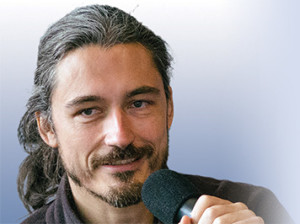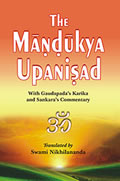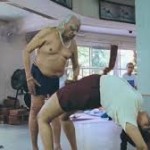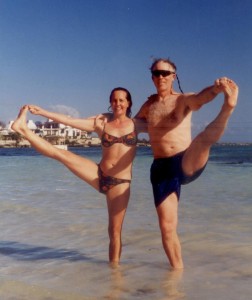Notes from the Boston classes: October 2016, and more …
 As we sail, swim and float through the inner sea of chi, we discover how to use yoga poses and explorations to transform dense, confused dysfunctional energy to a more integrated, coherent subtle energy. We can then use the subtle energy to strengthen and heal the psyche/soul and refine our emerging adventures in the imaginal realm.
As we sail, swim and float through the inner sea of chi, we discover how to use yoga poses and explorations to transform dense, confused dysfunctional energy to a more integrated, coherent subtle energy. We can then use the subtle energy to strengthen and heal the psyche/soul and refine our emerging adventures in the imaginal realm.
Sounds easy, but it is not. Most of the dysfunctional energy, expressed both personally and culturally, is not going away easily and we need to develop a strong sense of the ‘discomfort resilience’ mentioned in the previous post. To be immersed in the world of form, the feminine path of awakening, requires to hold a vast spaciousness to contain the suffering within and without that we will feel deeply. The current election insanity makes that very clear. Old patterns, deeply embedded in the cultural DNA, are also resilient.
Some very well known spiritual guidance is available to us on this journey. Patanjali describes the transformation of dense to subtle energy on the personal level in his second sutra on asana seen below. The whole of Lao Tzu’s Tao Te Ching is devoted to the transformation on the personal and societal level.
II-47 pra-yatna shaithilyaananta sam-aa-pattibhyaam
With the release of effort and absorption in the limitless (posture is mastered).
There are two parts to Patanjali’s observation about refining asana practice. Both imply that the inherent tendency of the body, of aliveness, is toward harmony. In part one, as balance is restored through yoga practice, there is more ‘just allowing’ of what is natural to emerge from within and less imposing from without. Effort here implies an addition of energy that is not quite aligned with the forces and currents of the moment. We need to be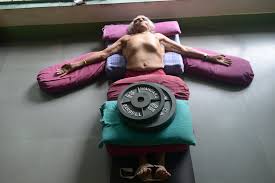 able to distinguish when our energetic actions are aligned, and when they are not. This requires listening, sensing and feeling as many layers of the body flow as possible. The fluid body is our link between structure and flow. Then action can be effortless. Taoists use the term wu wei, literally meaning no effort.
able to distinguish when our energetic actions are aligned, and when they are not. This requires listening, sensing and feeling as many layers of the body flow as possible. The fluid body is our link between structure and flow. Then action can be effortless. Taoists use the term wu wei, literally meaning no effort.
Patanjali’s second observation also comes right from Taoism. When the organism is whole and aligned in gravity, the whole cosmos is present in support. This is ananta, the serpent-couch of Vishnu, the sustainer of the cosmos, the sustainer of the pose. Our path is absorption in ananta, resting in the Tao, living fully alive.
From the Tao Te Ching, Chapter 37, Nameless Simplicity (Stephen Mitchell translation)
The Tao never does anything
Yet through it all things are done
If powerful men and women could center themselves in it,
the whole world would be transformed
by itself, in its natural rhythms.
People would be content
with their simple, everyday lives,
in harmony, and free of desire.
When there is no desire
all things are at peace.
We have a long way to go…
My Definitions:
Dense energy is out of phase with the inherent coherent flow of life in the body/mind/cosmos. It manifests as unnecessary effort, strain or contraction in the tissues and sense organs and accumulates over time creating the dense energy body. It can also be felt as unhealthy emotions, dysfunctional belief systems and other forms of stored trauma wired into the system.
Subtle energy is in harmony with the deepest expressions of health and coherence, the Tao, within and without, and in the body can be felt as subtle energy currents, waves and tidal flows.
Imaginal Realms: Emergent expressions of fundamental aliveness that connect the deeper levels of embodied cellular intelligence, through the dream process, to levels of reality outside the normal constraints of space and time. A major shift in human consciousness is taking place here.
The Process:
In a yoga pose, sequence or full practice, the main point is to awaken, and deeply refine our sensitivities so we can feel when we are in balance, and when we are not. The fluid body, the inner sea of chi, is where we travel, feel, sense, notice and align ourselves to the deeper realms of cosmic intelligence. This in turn will help us enliven and balance all levels of our energy so that when we go out into the world, we can bring some level of maturity, equanimity, kindness and creativity into our relationships. Same with our journeys into the realms beyond time and space. How might we go about this?
Cosmic Orientation and the Seven Sacred Directions
 The seven sacred directions give us a 3 dimensional model or map, with 3 axes and a center point, to help monitor and modulate our journey through the sea of chi. As our attention flows through the 3 dimensional space, we open the polarity of the axes through the center point, so that the energy and information flows both ways. We can then let attention come back to the center, the heart, and dissolve into infinite spacious awareness where the deepest healing takes place.
The seven sacred directions give us a 3 dimensional model or map, with 3 axes and a center point, to help monitor and modulate our journey through the sea of chi. As our attention flows through the 3 dimensional space, we open the polarity of the axes through the center point, so that the energy and information flows both ways. We can then let attention come back to the center, the heart, and dissolve into infinite spacious awareness where the deepest healing takes place.
1st direction. Open your heart. It always begins and ends in the heart. It is almost a cliche, but the primary practice/orientation is to awaken and open our hearts and establish a stable base there. Over and over, 24/7/365.24…. Feel your heart by touching your sternum, breathing into the chest, or any other way that allows you to make embodied connection with your physical heart. Be there. Stay there.
2nd direction. Open to Mother Earth also known as grounding or awakening the yin energy. Feel a line of energy/love growing down from your heart, through your root chakra deep into Mother Earth. Establish your connection to the underworld. Stabilize this. Patanjali calls this sthira, the stability of Mother Earth and gravity.
3rd direction: Open to Father Sky. From your heart center, open through your crown chakra to the sky and heavenly realms. Feel the lightness and spaciousness, the sukham of the sky. Connect back through your heart down to Mother Earth and return from Mother up to the heavens. Feel the open channel connecting Father, Mother and You, in the holy trinity.
You have now opened your primary axis/chakra line, head to tail, heaven to earth, 7th to 1st chakras. We will return to this also, again and again, every moment, every pose. It is where we connect most deeply with the cosmic axis of ananta in sitting and standing.
4th and 5th directions: Right and Left. From the chakra line, expand sideways in both directions, right and left. This is the emergence of our bi-lateral symmetry, two sides of the brain all the way to our two hands and feet. For most cultures, the front body is associated with the east and the rising sun, which makes the right side the south, and the left the north. We all have dominant sides, from hands and feet to eyes and ears. Balance involves allowing right and left to communicate with each other, through the central axis/chakra line. Key postures accentuating this include anantasana, trikonasana, ardha chandrasana, and all twists.
6th and 7th directions: Front and Back, the most difficult to orient to. We use the navel and umbilicus as our entry into this line and embryological flexion/extension to explore its deeper dimensions. Backbends open the front line by releasing the endodermal/gut body, organs, from mouth to anus, from compression. Forward bends open and soothe the back body/ectodermal nervous system.
The Postures:
Sitting: Start in any comfortable seated position. Center your self in your heart, open the chakra line, right/left and front/back spaces. Track sensations in all directions with the help of the breath. Where is there ease of expanding/condensing? This is the subtle energy we want to nurture and expand. In what directions/locations are there sensations of dullness or collapse? Where are there sensations of tightness and over exertion? These are examples of dense energy we are looking to transform.
Dullness or collapse definitely is an unconscious habit coming from the past. The tension of over exertion may also be old, but it could also be coming from a belief that this is what is supposed to be happening in the pose. We are all programmed to over work and rarely recognize this. This is where the feeling of effortlessness has to be discovered. Our habit is to identify with the gross body, the muscles specifically in asana, and use them as the anchor of the posture. When sthira, the lightness and spaciousness become a key component of our attention and feeling, we can begin to work less from the dense energy of muscles and more from a subtle energy of deeper realms of the prana or chi.
This is not to imply that the muscles are not engaged. Just that the access to them comes from a more subtle and integrated aspect of the energy field. There is a Sanskrit word ‘rasa’, which roughly translates as taste or essence, and in spiritual practice refers to a ‘taste’ of enlightenment, like a drop of nectar from the gods. This rasa is felt in the body in the fluids as the source of aliveness and it is this sense that we are looking for to guide our travels through and with the body. So as you sit, taste the delight where you can find it and stay there, savoring it. When the attention goes to effort or collapse, reconnect with the rasa of the pose. In cranio-sacral practice, the cerebro-spinal fluid is referred to as liquid light and there is a strong possibility that this is the ‘rasa’. Whatever we call it, find it!!
Standing: In tadasana, notice how your legs continue the chakra line through the feet into Mother Earth. Also find your imaginal energy tail to further open and ground the 1st chakra. When your stability comes from a fluid energetic connection through the chakras into the gravity, the unnecessary tension can dissolve, somewhat. There will still be lines and more complex patterns of tension that will persist, but if you can find, feel and nurture the subtle energies that are liberated through the energetic alignment, they become your resource sustaining the pose, whatever it may be. Explore all you favorite standing poses this way.
Forward and Backbending: The subtle energies of flexion and extension come from our embryological origins. Digest this lovely animation to get a feel of the these motions. There is folding from head to tail, and also a folding or wrapping around from back to front along the sides of the body. https://www.youtube.com/watch?v=qMnpxP6EeIY
We all tend to collapse the endodermal organs/front body in forward flexion, and overwork the large erector spinae muscles in back bending. Somewhere inside of you is the embryological field that allows these movements to be more and more effortless. Of course, even the embryological fields have distortions and other issues, but, none-the -less, the power of the subtlety is still very present. In time we can begin to heal the embryological field patterns as well.
Fun with a Taoist approach to the Breath: Looping Viloma Pranayama. In this variation, we balance yin and yang energies through in breath and out breath, and the action of the ribs and diaphragm, transforming dense energy into subtle energy. Remember, inhalation, the action of the prana vayu is an expansion centered in the chest 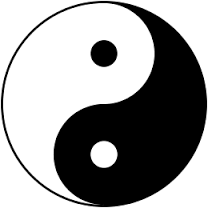 and spreading all the way through the diaphragm into the skull and pelvis. Exhalation, the action of the apana vayu is a squeezing or condensing centered in the lower abdomen and acting from the pelvic floor to the the volume just below the diaphragm, and subtly including the intercostal muscles. Each is actually supported by and contains a seed of the other.
and spreading all the way through the diaphragm into the skull and pelvis. Exhalation, the action of the apana vayu is a squeezing or condensing centered in the lower abdomen and acting from the pelvic floor to the the volume just below the diaphragm, and subtly including the intercostal muscles. Each is actually supported by and contains a seed of the other.
Over time, many people lose the support and balance of the vayus, as the chest collapses and the belly distends. The diaphram, ribs and spine all become tight and constricted. In this variation of viloma, we encourage the prana vayu/chest to sustain a sense of expansion and the apana vayu/abdominal wall to sustain a sense of condensing, during both inhalation and exhalation. Traditional viloma divides the inhalation and exhalation into smaller steps with pauses in between, like walking up and down stairs. The pauses are mini kumbhakas or retentions and prepare you for longer retentions as your practice matures. Three pauses is a commonly taught style, but you may have more or less as you feel your way through the practice. We will use the pauses a little differently.
Viloma I: inhalation with pauses. The tendency here will be to use dense energy to drive the in breath. We want to change this. Take a few minutes to relax and settle in to a comfortable breathing pattern, lying or sitting as you prefer. When ready to begin viloma, pause after the first third and notice. Am I tensing up anywhere, especially along the spine, bit also in the neck and shoulders, sense organs, pelvis or legs. If so, use the pause the relax the dense energy in as many of these places as possible. Soften the spine without collapsing the chest as the key to this. Increase the abdominal tone to help sustain the chest lifting.
You may actually feel that you are exhaling slightly. No problem. In the beginning, releasing tension will also release some air. As you become familiar with the practice, the release during the pause will just be of the dense energy. Repeat for two or more pauses, and then exhale evenly. If the exhaltion is strained, do a shorter cycle next time. It may feel like: inhale 1,2, 3, exhale 1, inhale 1,2,3, exhale 1, inhale 1,2,3, even exhalation, rest. Over time the expansion of the chest becomes more supported by abdominal tone. As the abdominal wall becomes stronger and more integrated, the diaphragm and chest open and soften more and more, allowing the in breath to be long and effortless.
Viloma II: Exhalation with pauses: Like Viloma I, only now the exhalation has pauses. The tendency here is to collapse the chest too quickly, cutting off the ability to complete a full exhalation. Use the pauses to recharge the prana vayu/chest, which may feel like a slight inhalation. Make sure the driving energy of exhalation is a squeezing of the abdominal cavity /apana vayu. Repeat for 2 or more cycles. It may feel like inhale, exhale 1,2, 3 inhale 1, 2, exhale 1,2,3, inhale 1,2, exhale 1,2 3 rest. Or whatever works for you.
Viloma II is my favorite because it totally changed my sense of the breath. As a beginner in pranayama, I could inhale faily easily, but my exhalations never felt complete. When I slowed the exhalation down in Viloma, and added a slight in breath on the pause, I finally felt that I could get the diaphragm and ribs to move together in harmony. The exhaltion/apana vayu began to support the inhalation/prana vayu and vice versa. From a Taoist perspective, the the seed of the yin supports the full expression of the yang and the seed of the yang supports the full expression of the yin.
A helpful exploration in structure: We had some fun awakening the clavicles, especially important in weight bearing poses like dog pose and hand balance, but also useful in all poses. First, achor the clavicle to the sternum at the sterno-clavicular joint. This is often unstable and unconscious. Use the fingers of one hand to hold this while you move the arm and sholder girdle around. Second, widen the clavicle out sidewasy toward the scapula without losing the anchored S-C joint. Feel the clavicle lengthening energetically in both directions. What ever else you do with the shouldrs and arms, do not lose this feeling. Start with climbing the wall and then go to dog pose and variations, hand stand, and any other poses you wish to explore.
Imaginal Practice:
1.Continue to develop your imaginal ‘sacred space’ / healing spa / refuge. Use all of your senses: what sounds do you hear? What are the scents and aromas wafting about? How does your body feel in the different areas of your healing garden?
 2.Develop a relationship with a gatekeeper. This person/entity will protect you, your space, your friends, but will also challenge you to grow. Ganesha is a very popular gatekeeper in India and he can be very helpful to us yogis. As a master of wisdom and knowledge, and a remover of obstacles, Ganesha will be a great gatekeeper for you. Chant his root mantra to help alert him to your presence.
2.Develop a relationship with a gatekeeper. This person/entity will protect you, your space, your friends, but will also challenge you to grow. Ganesha is a very popular gatekeeper in India and he can be very helpful to us yogis. As a master of wisdom and knowledge, and a remover of obstacles, Ganesha will be a great gatekeeper for you. Chant his root mantra to help alert him to your presence.
Om gam ganapataye namaha


